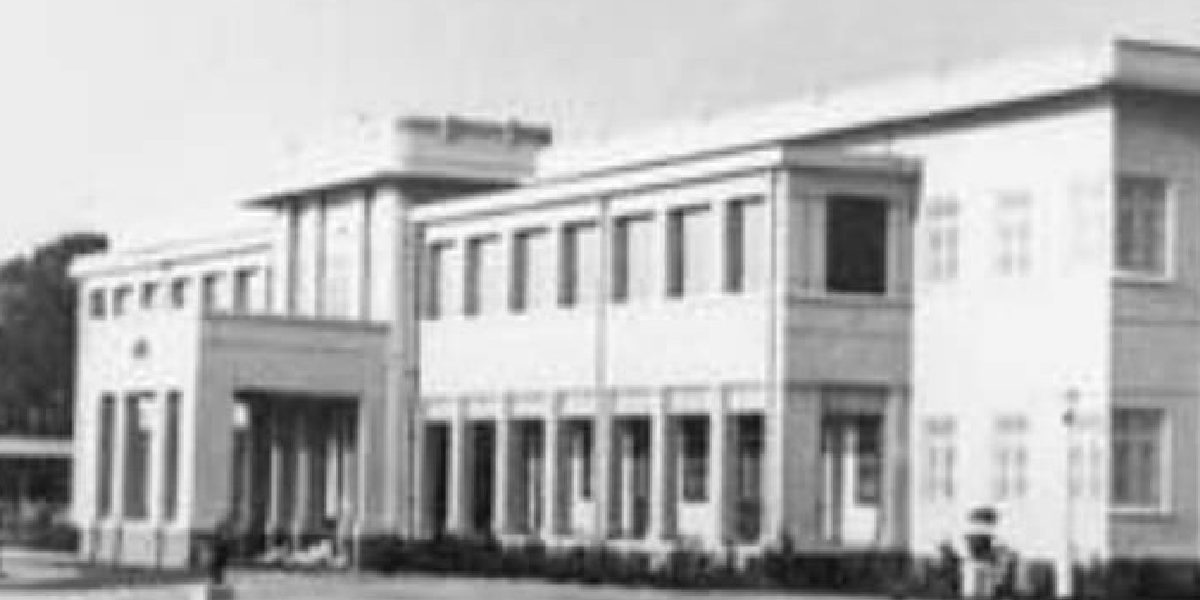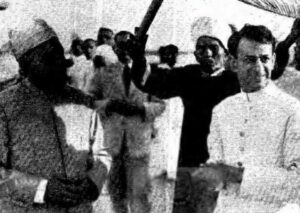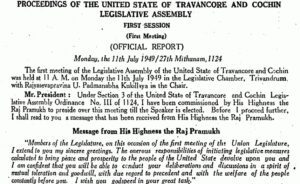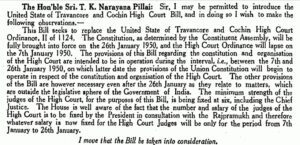Ernakulam MP Hibi Eden was not the first to demand that Kerala's capital should be shifted from Thiruvananthapuram to Ernakulam.

The United State of Travancore and Cochin High Court building. It was Ram Mohan Palace that became the high court complex. (Kochi Heritage Project)
A year before the Lok Sabha elections, the Congress MP representing Ernakulam in the Lower House, Hibi Eden, played a card in Parliament that boomeranged on him — not only did it cause widespread outrage, it even invited criticism from his own party colleagues.
The MP moved a Private Member’s Bill (State Capital Relocation Bill, 2023) in the Lok Sabha, requesting a shift in Kerala’s capital to Kochi from Thiruvananthapuram.
Eden, however, was not the first lawmaker to raise such a demand.
The demand was first made in 1949, much before Kerala was formed by merging Travancore–Cochin with Malabar and the Kasaragod taluk of South Canara under the States Re-organisation Act in 1956.
South First travelled down memory lane to take a closer look at the demand, the reasons, and its subsequent rejection.
The United State of Travancore and Cochin (USTC) came into existence by merging two erstwhile princely states, Travancore and Cochin, on 1 July, 1949.

The last Maharaja of Cochin, Sri Rama Varma Parikshit Thampuran, and the last Maharaja of Travancore, Sree Chithira Thirunal Balarama Varma, at Trivandrum while discussions on the integration of Travancore and Cochin were in progress. (Kochi Heritage Project)
A tug-of-war ensued with a section of legislators tenaciously demanding the shifting of the state capital from Trivandrum (now Thiruvananthapuram) to Ernakulam. The opposing group wanted the high court shifted from Ernakulam to Thiruvananthapuram.
Even before the formation of the USTC, heated debates over acceding to the Union of India were going on for almost four months, ever since the visit of Secretary of States Ministry VP Menon to Travancore.
Menon, who arrived in Trivandrum on 5 March, 1949, placed three options: Form a linguistic province or Aikya Keralam (United Kerala) of the entire Malayalam-speaking areas of Travancore, Cochin, and Malabar, or form a union of Travancore and Cochin, or leave the two states as they were for the time being.
The secretary, who favored the integration of the two states as “it would be the right step”, cajoled political leaders, legislators, and royal families into choosing this option.
In the days and months that followed, hectic parleys on the integration option were held in Travancore, Cochin, and in Delhi. In Menon’s words, “One of the problems that demanded immediate attention was the capital of the United State.”
Menon elucidated the drawbacks of both Ernakulam and Trivandrum in The Story of the Integration of the Indian States (1956). “Ernakulam, the capital of Cochin, was unsuitable mainly on account of its lack of accommodation,” he noted.

The first address made by the last ruling king of Travancore Sree Chithira Thirunal Balarama Varma during the inaugural session of United State of Travancore and Cochin Legislative Assembly. (Sourced)
At the same time, “Trivandrum, the capital of Travancore, had plenty of accommodation, but was situated so far south that it would cause considerable inconvenience to the people of Cochin.”
Menon further pointed out the impracticality of moving the capital to Ernakulam. “A new capital in a central place would involve an expenditure which the state could not well afford.”
He then revealed the settlement reached between the two princely states when they merged.
“A compromise was therefore reached by which it was decided to have the capital at Trivandrum and the High Court and the Law College at Ernakulam. This decision had the concurrence of the ministers of both states,” he said.
Arriving at the compromise, however, was not easy. There were reports of disagreement in general and discord between ministers in the TK Narayana Pillai-led USTC ministry.

The United State of Travancore and Cochin High Court Bill presented by United State of Travancore and Cochin Chief Minister TK Narayana Pillai. (Sourced)
A heated argument reportedly broke out between Minister for Education and Labour Panampilli Govinda Menon and Minister for Works and Communications E John Philipose over the issue.
While the former represented the Chalakkudy constituency in the USTC Legislative Assembly of 1949-50, the latter represented the Thiruvalla constituency.
As the dust settled, the Assembly convened its first session on 11 July, 1949. In the following sessions, members questioned the practicality of locating the state capital in Thiruvananthapuram and establishing the high court in Ernakulam.
On 6 August, 1949, Dr T Francis, who represented Ernakulam in the Assembly, tried to highlight the hardships people in the northern parts faced since the capital was in the south.
The member demanded the government consider the travel woes and the expenses involved.
However, chief minister Pillai dismissed the demand, saying, “At whatever place the capital lies, travel woes and expenses will be common.”
While KR Elankath, representing Trivandrum, informed the House that states like Madras province don’t have centrally-located capitals. CC Prasad, representing Kodakara, countered, listing states with capitals at the centre.
Responding to the debate, the chief minister said, “I don’t believe that a state capital should come at a place which is convenient to all.”
On 22 August, 1949, Muvattupuzha member NP Varghese raised a demand for developing a new capital for the USTC.
He asserted that the people would cooperate with the government if it builds a capital city within a specified time frame. The member also suggested acquiring about 25 square miles of land between Alwaye (now Aluva) and Ernakulam and urged the government to draw up a scheme for a planned city like New Delhi.
The chief minister answered that the question of building a new capital for the Union had not “seriously engaged the attention of the government”.
“If ultimately it is found desirable and necessary to have a new capital, the government may think of appointing a committee to draw up a plan and work out the details,” he replied,
However, when the member asked whether a centrally located state capital would be more convenient, Pillai said that “convenience depends on a lot of factors”.
As the capital issue slowly fizzled out, another hot topic cropped up. It was over the decision to set up the high court at Ernakulam since the “separation of judiciary from executive” was needed for the smooth functioning of the state.
Though the public discussed the matter ever since the merger conditions were finalised, the legislature took up the issue only when it considered the USTC High Court Bill on 30 November, 1949 — well after the High Court of Travancore-Cochin was inaugurated on 7 July, 1949.
It was Pattom A Thanu Pillai of Trivandrum who first objected to the move. According to him, the location of the high court in Ernakulam was a matter of reconsideration.
However, it was D Gnanasigamoni of Kalkulam who made some scathing remarks against the government on the high court issue when the Assembly took up the Bill for consideration on 8 December, 1949.
He alleged that locating the high court in Ernakulam, away from the capital, was an “act of stupendous folly”. He was of the view that as long as Trivandrum remained the capital, the high court should also be located there.
“…the indecent haste with which the decision was taken and still more indecent haste with which the change was brought about does little credit to any government which calls itself a democratic government”, Gnanasigamoni said.
However, the chief minister put the matter to rest. He categorically stated that the location of the high court at Ernakulam had been fixed after “considering” and “respecting” public opinion.
In his book Political and Administrative Integration of Princely States (2005), social historian SN Sadasivan stated that some judicial officers, other officers, and political leaders used coercion and other tactics to have the high court in Ernakulam.
“The chief justice and justices of the Cochin High Court emphasised that the separation of the judiciary from the executive would be more effective if they were geographically separated at the first instance and that the integration should not be a “political suicide” of Cochin to the advantage of Travancore,” Sadasivan noted.
The move was successful as the government promulgated an ordinance for establishing the high court in Ernakulam.
Sadasivan argued that in the light of widespread fear by those in Cochin that their “little Cochin” was the loser in the game of integration, protests by a section of people in Travancore against locating the high court in Ernakulam were ignored.
The Buch Report holds much significance when it comes to the integration of Travancore and Cochin. The report prepared by a committee headed by NM Buch, a civil servant, touched upon the administrative and other problems connected with the integration and provided solutions.
In Menon’s words, “(The Buch Report) helped greatly in settling some of the more pressing problems on the spot.”
However, the contents of the report remained undisclosed. The government did not reveal the details of the report for unknown reasons. Though the report was not confidential, the government offered a lame excuse that it could not be distributed among the Assembly members since there were not enough copies.
On 21 January, 1950, chief minister Pillai informed the Assembly that the printing of the Buch Report had been completed and would be published in two days. Then on 1 April, 1950, he informed the House that the report was published on 23 January ,1950, but there were not enough copies available.
Interestingly, the government informed the Assembly on 31 October, 1952, that the Buch Committee Report was never published and no copies of the report were supplied to the members of the legislature.

Jul 26, 2024

Jul 26, 2024

Jul 25, 2024

Jul 25, 2024

Jul 25, 2024

Jul 24, 2024